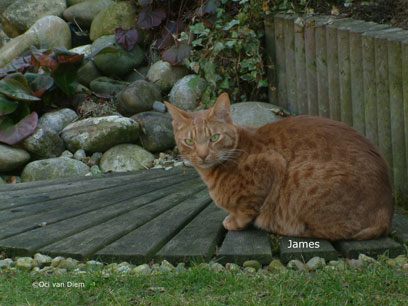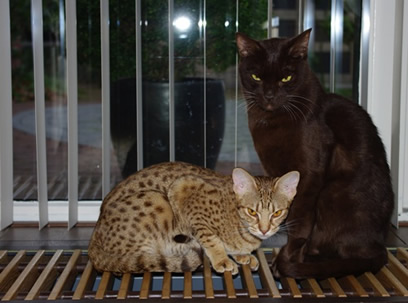The Ocicat
Creation
The Ocicat breed was created in 1964, by Virginia Daly who tried to breed an aby-point siamees by crossing a sealpoint siamese with an abbessian. The kittens from this litter were then crossed again with a siamese. A beautiful little kitten was born in this litter. Tonga. The daughter of the cat breeder thought that Tonga looked very much like an Ocelot and suggested to name this cross Ocicat. The American shorthair was later added to the new breed, bringing a silvery colour and this also responsible for the bonestructure, size and weight of the contemporary Ocicat.

Acceptance of the breed
The first Ocicat was registered with the American CFA (Cat Fanciers Association) in 1966. In 1984 a number of breeders started "Ocicat International". After much effort of the members of this association, the ocicat finally received it champion status in 1987. From that time is was no longer allowed to crossbreed with Siamese and American Shorthairs. The breed was formally acknowledged by the FIFE in 1992. More than 50 years passed since Mrs Daly discovered little Tonga in one of her litters and in that time the ocicat has developed into a fully feldged breed. This, and its current popularity, is mostly due to its natural beauty, its unique genetic composition and especially because of its likeable character and behaviour.
The ocicat was first introduced into Holland in the early 90s, originally coming from the States, Finland and Sweden. This means that there is enough genetic variation to sucessfully breed the ocicat for several years to come.
Health
As far as we are aware there are few health problems specifically related to the ocicat. The resolution from the CFA to allow cross breeding with Abbyssinians until the year 2030 will guarantee the creation of new bloodlines.
Appearance
Not only spotted kittens are born but also blotched or solid. These kittens also have the same unique character and the build of the ocicat and are definately as nice and beautiful. They are, however, less suitable for catshows.
The pattern on the coat of the cat is very special. Almost all inividual hairs are spotted. This means that the dark tips of the hairs form a spot, often like a thumb impression. The bigger the spots the better! Also the cat should have one bigger spot on both sides of its body: the so-called "bulls-eye".
There are 12 recognised colours: tawny, chocolate, cinnamon, blue, lilac and fawn and the same colours with silver undercoat.
The ocicat is an average to large size cat and it is muscled and firm, while at the same time radiating a certain elegance. The female weighs between 3,5 and 5 kilograms. The male can weigh up to 8kg. The cat is deceptively heavy in relation to its weight and the elegant impression that people get of an Ocicat. The shape of the head is a little square with an average length nose. The ears are relatively big and are almost in line with the rest of the head. A smaller spot on each earis highly desired! Their eyes are very pretty and normally come in all colours except blue. Ocicats have the ability to turn their head very far. They love to turn their backs to someone and then stare over their shoulder.
The paws are average of length and have firm oval feet. The hindlegs are longer then the frontlegs. The tail is relatively long and darker at the tip. The coat is short, sleek and shines like silk. It will feel very soft to touch, whilst not being too long or too woolly.
One thing is for sure though, it does not matter how beautiful the Ocicat is, it's essence just cannot be captured in a photograph....you will need to experience it!